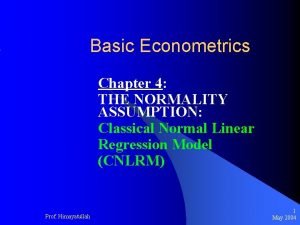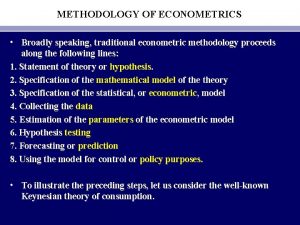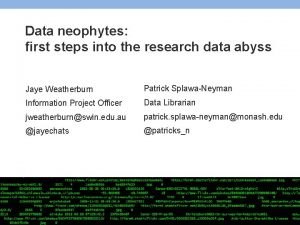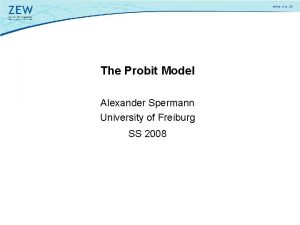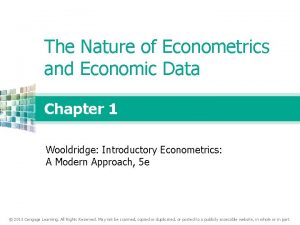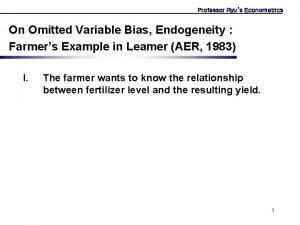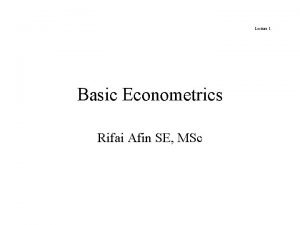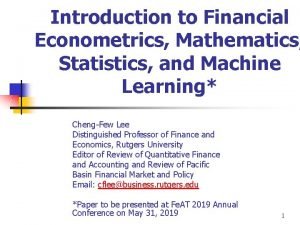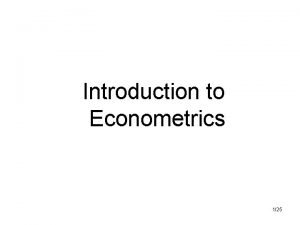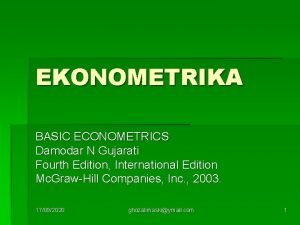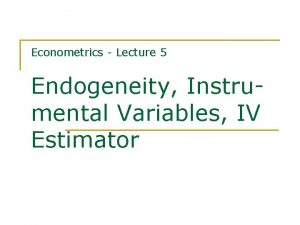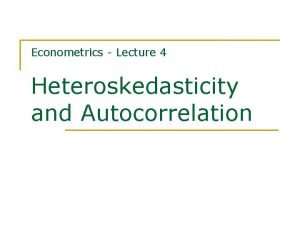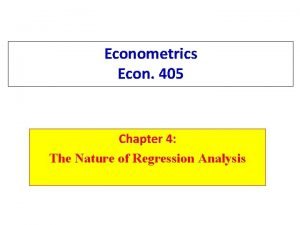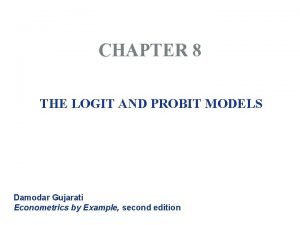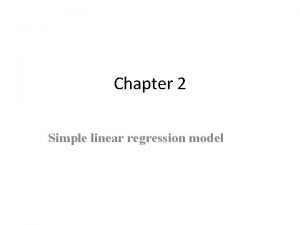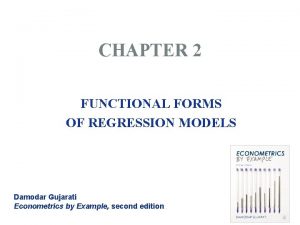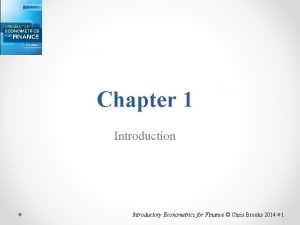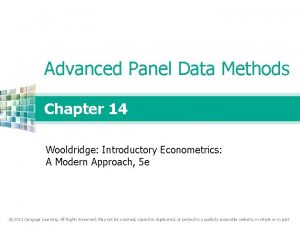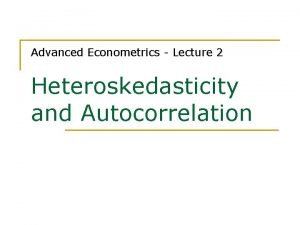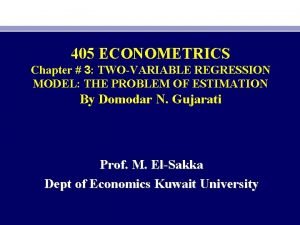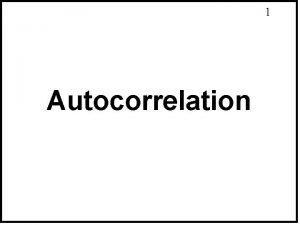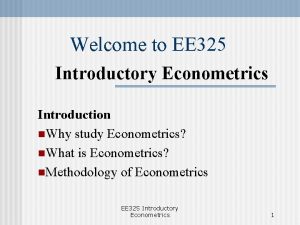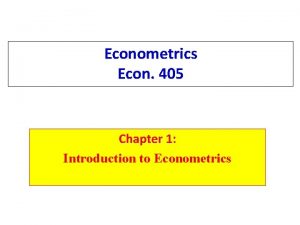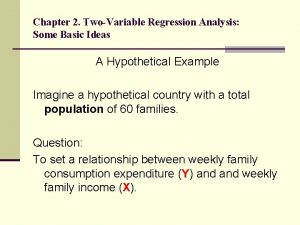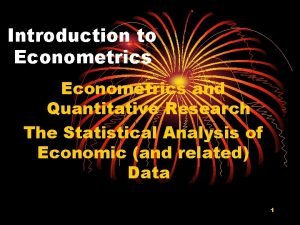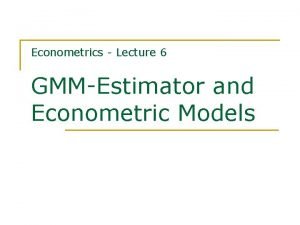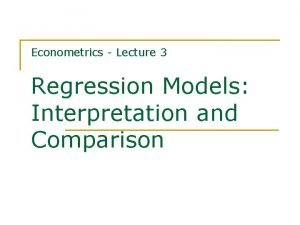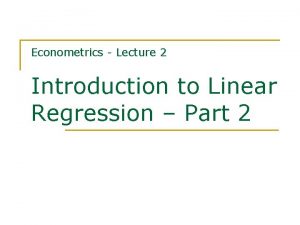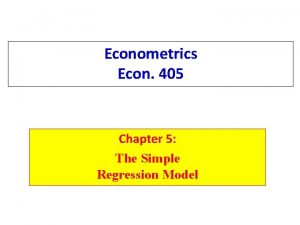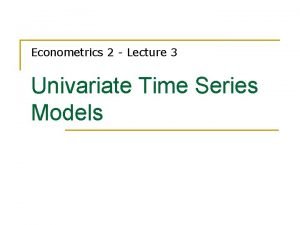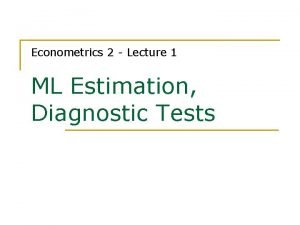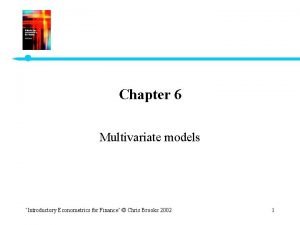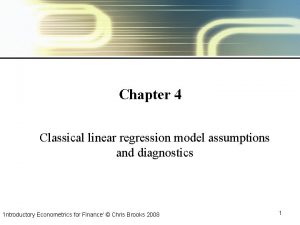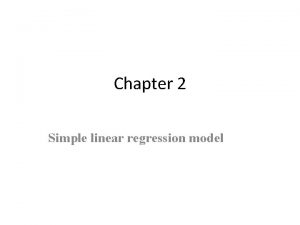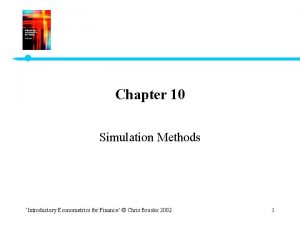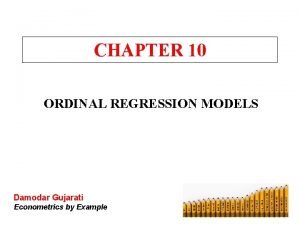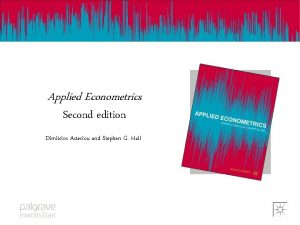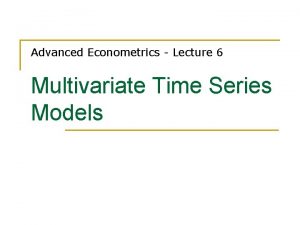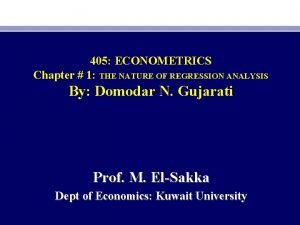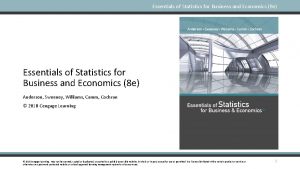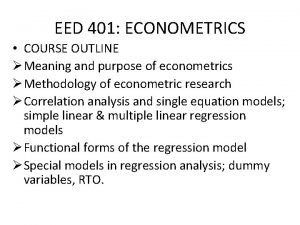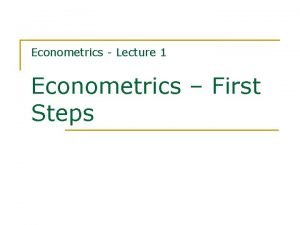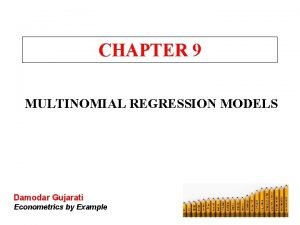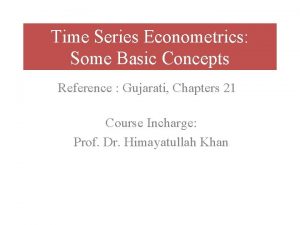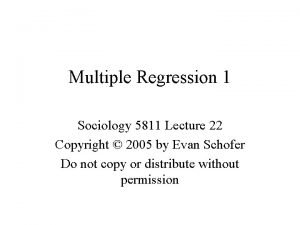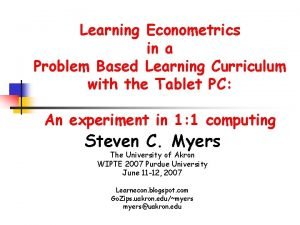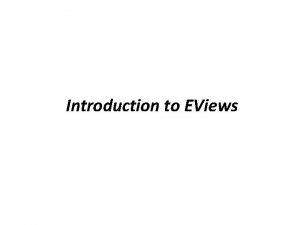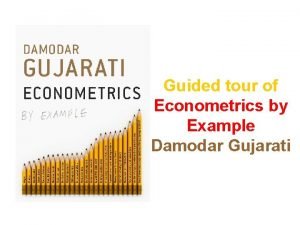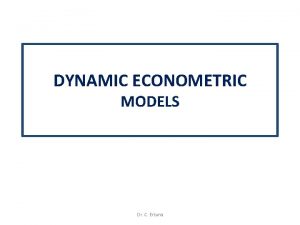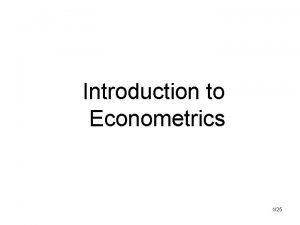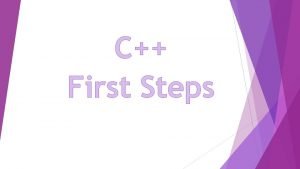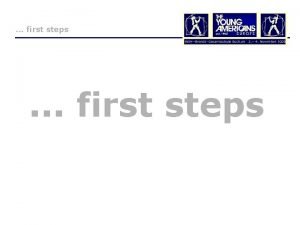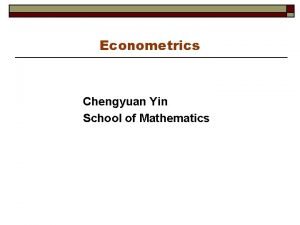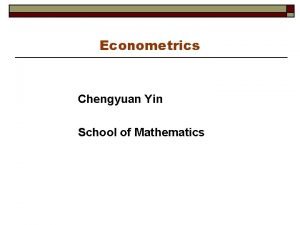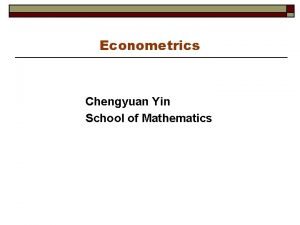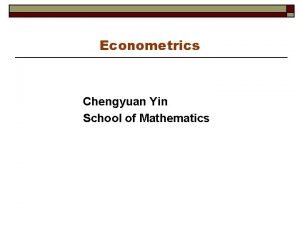Econometrics Lecture 1 Econometrics First Steps Contents n





























































- Slides: 61

Econometrics - Lecture 1 Econometrics – First Steps

Contents n Organizational Issues Some History of Econometrics n An Introduction to Linear Regression n n q OLS: An Algebraic Tool q The Linear Regression Model q Small Sample Properties of the OLS Estimator Introduction to GRETL Oct 9, 2015

Organizational Issues Course schedule Class Date 1 Fr, Oct 9 2 Fr, Oct 16 3 Fr, Oct 30 4 Fr, Nov 6 5 Fr, Nov 27 6 Fr, Dec 4 Time: 10: 30 -12: 00, 12: 30 -14: 00 begin 9: 30 on 30 Oct? Oct 9, 2015

Organizational Issues, cont’d Aims of the course n Understanding of econometric concepts and principles n Introduction to commonly used econometric tools and techniques n Use of econometric tools for analyzing economic data: specification of adequate models, identification of appropriate econometric methods, estimation of model parameters, interpretation of results n Use of GRETL Oct 9, 2015

Organizational Issues, cont’d Literature Course textbook n Marno Verbeek, A Guide to Modern Econometrics, 3 rd Ed. , Wiley, 2008 Suggestions for further reading n Jeffrey M. Wooldridge, Introductory Econometrics, 5 th Ed. , South. Western College Publishing, 2012 n William H. Greene, Econometric Analysis. 7 th Ed. , Prentice Hall, 2011 Oct 9, 2015

Organizational Issues, cont’d Prerequisites n Linear algebra: linear equations, matrices, vectors (basic operations and properties) n Descriptive statistics: measures of central tendency, measures of dispersion, measures of association, frequency tables, histogram, scatter plot, quantile n Theory of probability: probability and its properties, random variables and distribution functions in one and in several dimensions, moments, convergence of random variables, limit theorems, law of large numbers n Mathematical statistics: point estimation, confidence interval, hypothesis testing, p-value, significance level Oct 9, 2015

Organizational Issues, cont’d Teaching and learning method n Course in six blocks n Class discussions, written homework (computer exercises, GRETL) submitted by groups of (3 -5) students, presentations of homework by participants n Final exam Assessment of student work n For grading, the written homework, presentation of homework in class and a final written exam will be of relevance n Weights: homework 40 %, final written exam 60 % n Presentation of homework in class: students must be prepared to be called at random Oct 9, 2015

Contents n Organizational Issues Some History of Econometrics n An Introduction to Linear Regression n n q OLS: An Algebraic Tool q The Linear Regression Model q Small Sample Properties of the OLS Estimator Introduction to GRETL Oct 9, 2015

Empirical Economics Prior to 1930 ies The situation in the early 1930 ies: n Theoretical economics aims at “operationally meaningful theorems“; “operational” means purely logical mathematical deduction n Economic theories or laws are seen as deterministic relations; no inference from data as part of economic analysis n Ignorance of the stochastic nature of economic concepts n Data: limited availability; time-series on agricultural commodities, foreign trade n Use of statistical methods for q q measuring theoretical coefficients, e. g. , demand elasticities representing business cycles Oct 9, 2015

Early Institutions n n n Applied demand analysis: US Bureau of Agricultural Economics Statistical analysis of business cycles: H. L. Moore (Columbia University): Fourier periodogram; W. M. Persons et al. (Harvard): business cycle forecasting; US National Bureau of Economic Research (NBER) Cowles Commission for Research in Economics q q q Founded 1932 by A. Cowles: determinants of stock market prices? Formalization of econometrics, development of econometric methodology R. Frisch, G. Tintner; European refugees J. Marschak (head 1943 -55) recruited people like T. C. Koopmans, T. M. Haavelmo, T. W. Anderson, L. R. Klein Interests shifted to theoretical and mathematical economics after 1950 Oct 9, 2015

Early Actors n n R. Frisch (Oslo Institute of Economic Research): econometric project, 1930 -35; T. Haavelmo, O. Reiersol J. Tinbergen (Dutch Central Bureau of Statistics, Netherlands Economic Institute; League of Nations, Genova): macro-econometric model of Dutch economy, ~1935; T. C. Koopmans, H. Theil Austrian Institute for Trade Cycle Research: O. Morgenstern (head), A. Wald, G. Tintner Econometric Society, founded 1930 by R. Frisch et al. q q Facilitates exchange of scholars from Europe and US Covers econometrics and mathematical statistics Oct 9, 2015

First Steps n R. Frisch, J. Tinbergen: q q n Macro-economic modelling based on time-series, ~ 1935 Aiming at measuring parameters, e. g. , demand elasticities Aware of problems due to quality of data Nobel Memorial Prize in Economic Sciences jointly in 1969 (“for having developed and applied dynamic models for the analysis of economic processes”) T. Haavelmo q q “The Probability Approach in Econometrics”: Ph. D thesis (1944) Econometrics as a tool for testing economic theories States assumptions needed for building and testing econometric models Nobel Memorial Prize in Economic Sciences in 1989 ("for his clarification of the probability theory foundations of econometrics and his analyses of simultaneous economic structures”) Oct 9, 2015

First Steps, cont’d n Cowles Commission q q Methodology for macro-economic modeling based on Haavelmo’s approach Cowles Commission monographs by G. Tintner, T. C. Koopmans, et al. Oct 9, 2015

The Haavelmo Revolution n Introduction of probabilistic concepts in economics q q q n Haavelmo‘s ideas q q q n Obvious deficiencies of traditional approach: Residuals, measurement errors, omitted variables; stochastic time-series data Advances in probability theory in early 1930 ies Fisher‘s likelihood function approach Critical view of Tinbergen‘s macro-econometric models Thorough adoption of probability theory in econometrics Conversion of deterministic economic models into stochastic structural equations Haavelmo‘s “The Probability Approach in Econometrics” q q Why is the probability approach indispensible? Modeling procedure based on ML estimation and hypothesis testing Oct 9, 2015

Haavelmo’s Arguments for the Probabilistic Approach n Economic variables in economic theory and econometric models q q n “Observational” vs. “theoretical” vs. “true” variables Models have to take into account inaccurately measured data and passive observations Unrealistic assumption of permanence of economic laws q q q Simplifying economic theories Selection of economic variables and relations out of the whole system of fundamental laws Economic time-series data Oct 9, 2015

Cowles Commission Methodology Assumptions based to macro-econometric modelling and testing of economic theories Time series model Yt = a. Xt + Wt+ u 1 t, Xt = g. Yt + d. Zt+ u 2 t 1. Specification of the model equation(s) includes the choice of variables; functional form is (approximately) linear 2. Time-invariant model equation(s): the model parameters a, …, d are independent of time t 3. Parameters a, …, d are structurally invariant, i. e. , invariant wrt changes in the variables 4. Causal ordering (exogeneity, endogeneity) of variables is known 5. Statistical tests can falsify but not verify a model Oct 9, 2015

Classical Econometrics and More n “Golden age” of econometrics until ~1970 q q q n Skepticism q q n Multi-equation models for analyses and forecasting Growing computing power Model Development of econometric tools Tinbergen Poor forecasting performance Dubious results due to n wrong specifications n imperfect estimation methods year eq‘s 1936 24 1950 6 Klein & Goldberger 1955 20 Brookings 1965 160 Brookings Mark II 1972 ~200 Klein Time-series econometrics: non-stationarity of economic time-series q q Consequences of non-stationarity: misleading t-, DW-statistics, R² Non-stationarity: needs new models (ARIMA, VAR, VEC); Box & Jenkins (1970: ARIMA-models), Granger & Newbold (1974, spurious regression), Dickey-Fuller (1979, unit-root tests) Oct 9, 2015

Econometrics … n n n … consists of the application of statistical data and techniques to mathematical formulations of economic theory. It serves to test the hypotheses of economic theory and to estimate the implied interrelationships. (Tinbergen, 1952) … is the interaction of economic theory, observed data and statistical methods. It is the interaction of these three that makes econometrics interesting, challenging, and, perhaps, difficult. (Verbeek, 2008) … is a methodological science with the elements q q Oct 9, 2015 economic theory mathematical language statistical methods computer software

Our Course 1. Introduction to linear regression (Verbeek, Ch. 2): the linear regression model, OLS method, properties of OLS estimators 2. Introduction to linear regression (Verbeek, Ch. 2): goodness of fit, hypotheses testing, multicollinearity 3. Interpreting and comparing regression models (MV, Ch. 3): interpretation of the fitted model, selection of regressors, testing the functional form 4. Heteroskedascity and autocorrelation (Verbeek, Ch. 4): causes and consequences, testing, alternatives for inference 5. Endogeneity, instrumental variables and GMM (Verbeek, Ch. 5): the IV estimator, the generalized instrumental variables estimator, the generalized method of moments (GMM) 6. The practice of econometric modelling Oct 9, 2015

The Next Course n n n Univariate and multivariate time series models: ARMA-, ARCH -, GARCH-models, VAR-, VEC-models Models for panel data Models with limited dependent variables: binary choice, count data Oct 9, 2015

Contents n Organizational Issues Some History of Econometrics n An Introduction to Linear Regression n n q OLS: An Algebraic Tool q The Linear Regression Model q Small Sample Properties of the OLS Estimator Introduction to GRETL Oct 9, 2015

Example: Individual Wages Sample (US National Longitudinal Survey, 1987) n N = 3294 individuals (1569 females) n n Variable list q WAGE: wage (in 1980 $) per hour (p. h. ) q MALE: gender (1 if male, 0 otherwise) q EXPER: experience in years q SCHOOL: years of schooling q AGE: age in years Possible questions q q Effect of gender on wage p. h. : Average wage p. h. : 6, 31$ for males, 5, 15$ for females Effects of education, of experience, of interactions, etc. on wage p. h. Oct 9, 2015

Individual Wages, Wage per hour vs. Years of schooling Oct 9, 2015 cont’d

Linear Regression Y: explained variable X: explanatory or regressor variable The linear regression model describes the data-generating process of Y under the condition X simple linear regression model : coefficient of X a: intercept multiple linear regression model Oct 9, 2015

Fitting a Model to Data Choice of values b 1, b 2 for model parameters 1, 2 of Y = 1 + 2 X, given the observations (yi, xi), i = 1, …, N Principle of (Ordinary) Least Squares or OLS: bi = arg min 1, 2 S( 1, 2), i =1, 2 Objective function: sum of the squared deviations S( 1, 2) = Si [yi - ( 1 + 2 xi)]2 = Si i 2 Deviation between observation and fitted value: i = yi - ( 1 + 2 xi) Oct 9, 2015

Observations and Fitted Regression Line Simple linear regression: Fitted line and observation points (Verbeek, Figure 2. 1) Oct 9, 2015

OLS Estimators Equating the partial derivatives of S( 1, 2) to zero: normal equations OLS estimators b 1 und b 2 result in with mean values and second moments Oct 9, 2015

Individual Wages, cont’d Sample (US National Longitudinal Survey, 1987): wage per hour, gender, experience, years of schooling; N = 3294 individuals (1569 females) Average wage p. h. : 6, 31$ for males, 5, 15$ for females Model: wagei = β 1 + β 2 malei + εi male. I: male dummy, has value 1 if individual is male, otherwise value 0 OLS estimation gives wagei = 5, 15 + 1, 17*malei Compare with averages! Oct 9, 2015

Individual Wages, cont’d OLS estimated wage equation (Table 2. 1, Verbeek) wagei = 5, 15 + 1, 17*malei estimated wage p. h for males: 6, 313 for females: 5, 150 Oct 9, 2015

OLS Estimators: General Case Model for Y contains K-1 explanatory variables Y = 1 + 2 X 2 + … + KXK = x’ with x = (1, X 2, …, XK)’ and = ( 1, 2, …, K)’ Observations: (yi, xi’) = (yi, (1, xi 2, …, xi. K)), i = 1, …, N OLS estimates b = (b 1, b 2, …, b. K)’ are obtained by minimizing the objective function wrt the k’s this results in Oct 9, 2015

OLS Estimators: General Case, cont’d or the so-called normal equations, a system of K linear equations for the components of b Given that the symmetric Kx. K-matrix has full rank K and is hence invertible, the OLS estimators are Oct 9, 2015

Best Linear Approximation Given the observations: (yi, xi’) = (yi, (1, xi 2, …, xi. K)), i = 1, …, N For yi, the linear combination or the fitted value is the best linear combination for Y from X 2, …, XK and a constant (the intercept) Oct 9, 2015

Some Matrix Notation N observations (y 1, x 1), … , (y. N, x. N) Model: yi = 1 + 2 xi + εi, i = 1, …, N, or y = X + ε with Oct 9, 2015

OLS Estimators in Matrix Notation Minimizing S( ) = (y - X )’ (y - X ) = y’y – 2 y’X + ’ X’X with respect to gives the normal equations resulting from differentiating S( ) with respect to and setting the first derivative to zero The vector of OLS solution or OLS estimators for is b = (X’X)-1 X’y The best linear combinations or predicted values for Y given X or projections of y into the space of X are obtained as ŷ = Xb = X(X’X)-1 X’y = Pxy the Nx. N-matrix Px is called the projection matrix or hat matrix Oct 9, 2015

Residuals in Matrix Notation The vector y can be written as y = Xb + e = ŷ + e with residuals e = y – Xb or ei = yi – xi‘b, i = 1, …, N n From the normal equations follows -2(X‘y – X‘Xb) = -2 X‘e = 0 i. e. , each column of X is orthogonal to e n With e = y – Xb = y – Pxy = (I – Px)y = Mxy the residual generating matrix Mx is defined as Mx = I – X(X’X)-1 X’ = I – Px Mx projects y into the orthogonal complement of the space of X n Properties of Px and Mx: symmetry (P’x = Px, M’x = Mx) idempotence (Px. Px = Px, Mx. Mx = Mx), and orthogonality (Px. Mx = 0) Oct 9, 2015

Properties of Residuals: ei = yi – xi‘b, i = 1, …, N n Minimum value of objective function S(b) = e’e = Si ei 2 n From the orthogonality of e = (e 1, …, e. N)‘ to each xi = (x 1 i, …, x. Ni)‘, i = 1, …, K, i. e. , e‘xi = 0, follows that Si ei = 0 i. e. , average residual is zero, if the model has an intercept Oct 9, 2015

Contents n Organizational Issues Some History of Econometrics n An Introduction to Linear Regression n n q OLS: An Algebraic Tool q The Linear Regression Model q Small Sample Properties of the OLS Estimator Introduction to GRETL Oct 9, 2015

US Wages US wages are gender-specific The relation wagei = β 1 + β 2 malei + εi with male. I: male dummy (equals 1 for males, otherwise 0) n describes the wage of individual i as a function of the gender n is true for each US citizen n β 1 and β 2 are unknown Given sample data (wagei, malei, i = 1, …N), OLS estimation of β 1 and β 2 may result in wagei = 5, 15 + 1, 17*malei n This is not a description of the sample! n But reflects a general relationship Oct 9, 2015

Economic Models Describe economic relationships (not just a set of observations), have an economic interpretation Linear regression model: yi = 1 + 2 xi 2 + … + Kxi. K + ei = xi’ + εi n n Variables yi, xi 2, …, xi. K: observable, sample (i = 1, …, N) from a well-defined population or universe Error term εi (disturbance term) contains all influences that are not included explicitly in the model; not observable; assumption E{εi | xi} = 0 gives E{yi | xi} = xi‘β n the model describes the expected value of y given x Unknown coefficients 1, …, K: population parameters Oct 9, 2015

Sampling in the Economic Context The regression model yi = xi’ + εi, i = 1, …, N; or y = X + ε describes one realization out of all possible samples of size N from the population A) Sampling process with fixed (deterministic), non-stochastic xi’s n New sample: new error terms εi, i = 1, …, N, and, hence, new yi’s n Joint distribution of εi‘s determines properties of b etc. n A laboratory setting, does not apply to the economic context B) Sampling process with samples of (xi, yi) or (xi, i) n New sample: new error terms εi and new xi, i = 1, …, N n Random sampling of (xi, i), i = 1, …, N: joint distribution of (xi, i)‘s determines properties of b etc. Oct 9, 2015

Sampling in the Economic Context, cont’d n The sampling with fixed, non-stochastic xi’s is not realistic for economic data n Sampling process with samples of (xi, yi) is appropriate for modeling cross-sectional data q n Example: household surveys, e. g. , US National Longitudinal Survey, EU-SILC Sampling process with samples of (xi, yi) from time-series data: sample is seen as one out of all possible realizations of the underlying data-generating process Oct 9, 2015

The Ceteris Paribus Condition n The linear regression model yi = xi’ + εi needs assumptions to allow interpretation n Assumption for εi‘s: E{εi | xi } = 0; exogeneity of variables X This implies E{yi | xi } = xi'b i. e. , the regression line describes the conditional expectation of yi given xi Coefficient k measures the change of the expected value of Y if Xk changes by one unit and all other Xj values, j ǂ k, remain the same (ceteris paribus condition) Exogeneity can be restrictive: E{εi | xi } = 0 implies that εi and xi are uncorrelated n n n Oct 9, 2015

Regression Coefficients Linear regression model: yi = 1 + 2 xi 2 + … + Kxi. K + ei = xi’ + εi Coefficient k measures the change of the expected value of Y if Xk changes by one unit and all other Xj values, j ǂ k, remain the same (ceteris paribus condition); marginal effect of changing Xk on Y Example n Wage equation: wagei = β 1 + β 2 malei + β 3 schooli + β 4 experi + εi β 3 measures the impact of one additional year at school upon a person’s wage, keeping gender and years of experience fixed Oct 9, 2015

Estimation of β Given a sample (xi, yi), i = 1, …, N, the OLS estimators for b = (X’X)-1 X’y can be used as an approximation for n The vector b is a vector of numbers, the estimates n The vector b is the realization of a vector of random variables n The sampling concept and assumptions on εi‘s determine the quality, i. e. , the statistical properties, of b Oct 9, 2015

Contents n Organizational Issues Some History of Econometrics n An Introduction to Linear Regression n n q OLS: An Algebraic Tool q The Linear Regression Model q Small Sample Properties of the OLS Estimator Introduction to GRETL Oct 9, 2015

Fitting Economic Models to Data Observations allow n to estimate parameters to assess how well the data-generating process is represented by the model, i. e. , how well the model coincides with reality n to improve the model if necessary Fitting a linear regression model to data n Parameter estimates b = (b 1, …, b. K)’ for coefficients = ( 1, …, K)’ n Standard errors se(bk) of the estimates bk, k=1, …, K n t-statistics, F-statistic, R 2, Durbin Watson test-statistic, etc. n Oct 9, 2015

OLS Estimator and OLS Estimates b OLS estimates b are a realization of the OLS estimator The OLS estimator is a random variable Observations are a random sample from the population n Observations are generated by some random sampling process Distribution of the OLS estimator n Actual distribution not known n Distribution determined by assumptions on q model specification n the error term εi and regressor variables xi Quality criteria (bias, accuracy, efficiency) of OLS estimates are determined by the properties of this distribution q Oct 9, 2015

Gauss-Markov Assumptions Observation yi is a linear function yi = xi' + εi of observations xik of the regressor variables Xk, k = 1, …, K, and the error term εi for i = 1, …, N; xi' = (xi 1, …, xi. K); X = (xik) A 1 E{εi} = 0 for all i A 2 all εi are independent of all xi (exogeneous xi) A 3 V{ei} = s 2 for all i (homoskedasticity) A 4 Cov{εi, εj} = 0 for all i and j with i ≠ j (no autocorrelation) In matrix notation: E{ε} = 0, V{ε} = s 2 IN Oct 9, 2015

Systematic Part of the Model The systematic part E{yi | xi } of the model yi = xi' + εi, given observations xi, is derived under the Gauss-Markov assumptions as follows: (A 2) implies E{ε | X} = E{ε} = 0 and V{ε | X} = V{ε} = s 2 IN n Observations xi, i = 1, …, N, do not affect the properties of ε n The systematic part E{yi | xi } = xi' can be interpreted as the conditional expectation of yi, given observations xi Oct 9, 2015

Is the OLS Estimator a Good Estimator? n n n Under the Gauss-Markov assumptions, the OLS estimator has favourable properties; see below Gauss-Markov assumptions are very strong and not always satisfied Relaxations of the Gauss-Markov assumptions and consequences of such relaxations are important topics in econometrics Oct 9, 2015

Properties of OLS Estimators 1. The OLS estimator b is unbiased: E{b | X} = E{b} = β Needs assumptions (A 1) and (A 2) 2. The variance of the OLS estimator b is given by V{b | X} = V{b} = σ2(Σi xi xi’)-1 = σ2(X‘ X)-1 Needs assumptions (A 1), (A 2), (A 3) and (A 4) 3. Gauss-Markov Theorem: The OLS estimator b is a BLUE (best linear unbiased estimator) for β Needs assumptions (A 1), (A 2), (A 3), and (A 4) and requires linearity in parameters Oct 9, 2015

The Gauss-Markov Theorem OLS estimator b is BLUE (best linear unbiased estimator) for β n Linear estimator: b* = Ay with any full-rank Kx. N matrix A n b* is an unbiased estimator: E{b*} = E{Ay} = β n b is BLUE: V{b*} – V{b} is positive semi-definite, i. e. , the variance of any linear combination d’b* is not smaller than that of d’b V{d’b*} ≥ V{d’b} e. g. , V{bk*} ≥ V{bk} for any k n The OLS estimator is most accurate among the linear unbiased estimators Oct 9, 2015

Standard Errors of OLS Estimators n Variance (covariance matrix) of the OLS estimators: V{b} = σ2(X’ X)-1 = σ2(Σi xi xi’)-1 n Standard error of OLS estimate bk: The square root of the kth diagonal element of V{b} Estimator V{b} is proportional to the variance σ2 of the error terms Estimator for σ2: sampling variance s 2 of the residuals ei s 2 = (N – K)-1 Σi ei 2 Under assumptions (A 1)-(A 4), s 2 is unbiased for σ2 Attention: the estimator (N – 1)-1 Σi ei 2 is biased Estimated variance (covariance matrix) of b: Ṽ{b} = s 2(X’ X)-1 = s 2(Σi xi xi’)-1 n n n Oct 9, 2015

Standard Errors of OLS Estimators, cont’d n Variance (covariance matrix) of the OLS estimators: V{b} = σ2(X’ X)-1 = σ2(Σi xi xi’)-1 n Standard error of OLS estimate bk: The square root of the kth diagonal element of V{b} σ√ckk with ckk the k-th diagonal element of (X’ X)-1 Estimated variance (covariance matrix) of b: Ṽ{b} = s 2(X’ X)-1 = s 2(Σi xi xi’)-1 Estimated standard error of bk: se(bk) = s√ckk n n Oct 9, 2015

Two Examples 1. Simple regression yi = a + xi + et The variance for the OLS estimator of is b is the more accurate, the larger N and sx² and the smaller s² 2. Regression with two regressors: yi = 1 + 2 xi 2 + 3 xi 3 + et The variance for the OLS estimator of 2 is b 2 is most accurate if X 2 and X 3 are uncorrelated Oct 9, 2015

Normality of Error Terms For the purpose of statistical inference, a distributional assumption for the εi‘s is needed A 5 εi normally distributed for all i Together with assumptions (A 1), (A 3), and (A 4), (A 5) implies εi ~ NID(0, σ2) for all i i. e. , all εi are n independent drawings n from the normal distribution n with mean 0 n and variance σ2 Error terms are “normally and independently distributed” (NID) Oct 9, 2015

Properties of OLS Estimators 1. The OLS estimator b is unbiased: E{b} = β 2. The variance of the OLS estimator is given by V{b} = σ2(X’X)-1 3. The OLS estimator b is a BLUE (best linear unbiased estimator) for β 4. The OLS estimator b is normally distributed with mean β and covariance matrix V{b} = σ2(X‘X)-1 b ~ N(β, σ2(X’X)-1), bk ~ N(βk, σ2 ckk) with ckk: (k, k)-element of (X’X)-1 Needs assumptions (A 1) - (A 5) Oct 9, 2015

Example: Individual Wages wagei = β 1 + β 2 malei + εi What do the assumptions mean? (A 1): β 1 + β 2 malei contains the whole systematic part of the model; no regressors besides gender relevant? (A 2): xi uncorrelated with εi for all i: knowledge of a person’s gender provides no information about further variables which affect the person’s wage; is this realistic? (A 3) V{εi} = σ2 for all i: variance of error terms (and of wages) is the same for males and females; is this realistic? (A 4) Cov{εi, , εj} = 0, i ≠ j: implied by random sampling (A 5) Normality of εi: is this realistic? (Would allow, e. g. , for negative wages) Oct 9, 2015

Individual Wages, cont’d OLS estimated wage equation (Table 2. 1, Verbeek) b 1 = 5, 1479, se(b 1) = 0, 0812: mean wage p. h. for females: 5, 15$, with std. error of 0, 08$ b 2 = 1, 166, se(b 2) = 0, 112 95% confidence interval for β 1: 4, 988 β 1 5, 306 Oct 9, 2015

Your Homework 1. Verbeek’s data set “wages 1” contains for a sample of 3294 individuals the wage p. h. (wage) and other variables. Using GRETL, draw (a) a scatter plot of wage over male, (b) draw a random 10% sub-sample and draw a factorized box plot for wage over male, and (c) scatter plots of wage over school and exper. Explain the relevant features of the graphs. 2. For Verbeek’s data set “wages 1”, calculate, using GRETL, the mean wage p. h. (a) of the whole sample, (b) of males and females, and (c) the standard deviation of the wage p. h. of males and of females. Oct 9, 2015

Your Homework, cont’d 3. For the sample (yi, xi), i = 1, . . . , N, and the linear regression (yi = 1 + 2 xi + i): write out the matrices X’X, (X’X)-1, and X’y as well as the OLS estimator b = (X’X)-1 X’y. 4. For the simple regression yi = a + xi + ei, i =1, . . . , N, show that the variance of the OLS estimate for is σ2/(Nsx 2), where σ2 is the error term variance, sx 2 the variance of the xi‘s. Oct 9, 2015
 Gujarati basic econometrics lecture notes ppt
Gujarati basic econometrics lecture notes ppt Methodology of econometrics steps
Methodology of econometrics steps 01:640:244 lecture notes - lecture 15: plat, idah, farad
01:640:244 lecture notes - lecture 15: plat, idah, farad What are axial movements?
What are axial movements? First steps in english linguistics chapter 8
First steps in english linguistics chapter 8 Thsteps quick reference guide
Thsteps quick reference guide First steps monash
First steps monash Probit model
Probit model Nature of econometrics
Nature of econometrics Confidence interval econometrics
Confidence interval econometrics Endogeneity econometrics
Endogeneity econometrics Dataset multiple linear regression
Dataset multiple linear regression Gujarati econometrics
Gujarati econometrics Nature and scope of managerial economics
Nature and scope of managerial economics Methodology of econometrics
Methodology of econometrics Importance of statistics in finance
Importance of statistics in finance Methodology of econometric analysis
Methodology of econometric analysis Ekonometrika test
Ekonometrika test Machine learning econometrics
Machine learning econometrics Endogeneity econometrics
Endogeneity econometrics Autocorrelation in econometrics
Autocorrelation in econometrics Econ 405
Econ 405 Probit econometrics
Probit econometrics Durbin chap
Durbin chap Population regression function definition
Population regression function definition Reciprocal model in econometrics
Reciprocal model in econometrics Introduction to econometrics for finance
Introduction to econometrics for finance Wooldridge econometrics slides
Wooldridge econometrics slides Autocorrelation in econometrics
Autocorrelation in econometrics Econometrics chapter 3
Econometrics chapter 3 Positive autocorrelation
Positive autocorrelation Methodology of econometrics
Methodology of econometrics Goals of econometrics
Goals of econometrics Econometrics
Econometrics Srf and prf in econometrics
Srf and prf in econometrics Bailey real econometrics
Bailey real econometrics Econometrics and quantitative economics
Econometrics and quantitative economics Econometrics
Econometrics Econometrics
Econometrics Econometrics
Econometrics Econometrics simple regression model
Econometrics simple regression model Econometrics
Econometrics Lm test econometrics
Lm test econometrics Econometrics
Econometrics Classical regression assumptions
Classical regression assumptions What is srf in econometrics
What is srf in econometrics Econometrics
Econometrics Damodar gujarati econometrics by example
Damodar gujarati econometrics by example Applied econometrics dimitrios asteriou
Applied econometrics dimitrios asteriou Econometrics
Econometrics Econometrics chapter 1
Econometrics chapter 1 Business econometrics
Business econometrics Course outline meaning
Course outline meaning Gauss markov assumptions
Gauss markov assumptions Gujarati econometrics
Gujarati econometrics Basic econometrics
Basic econometrics Econometrics basic concepts
Econometrics basic concepts Dummy variable in econometrics
Dummy variable in econometrics Case based learning adalah
Case based learning adalah Econometrics views
Econometrics views Damodar gujarati econometrics by example
Damodar gujarati econometrics by example What is econometrics
What is econometrics
